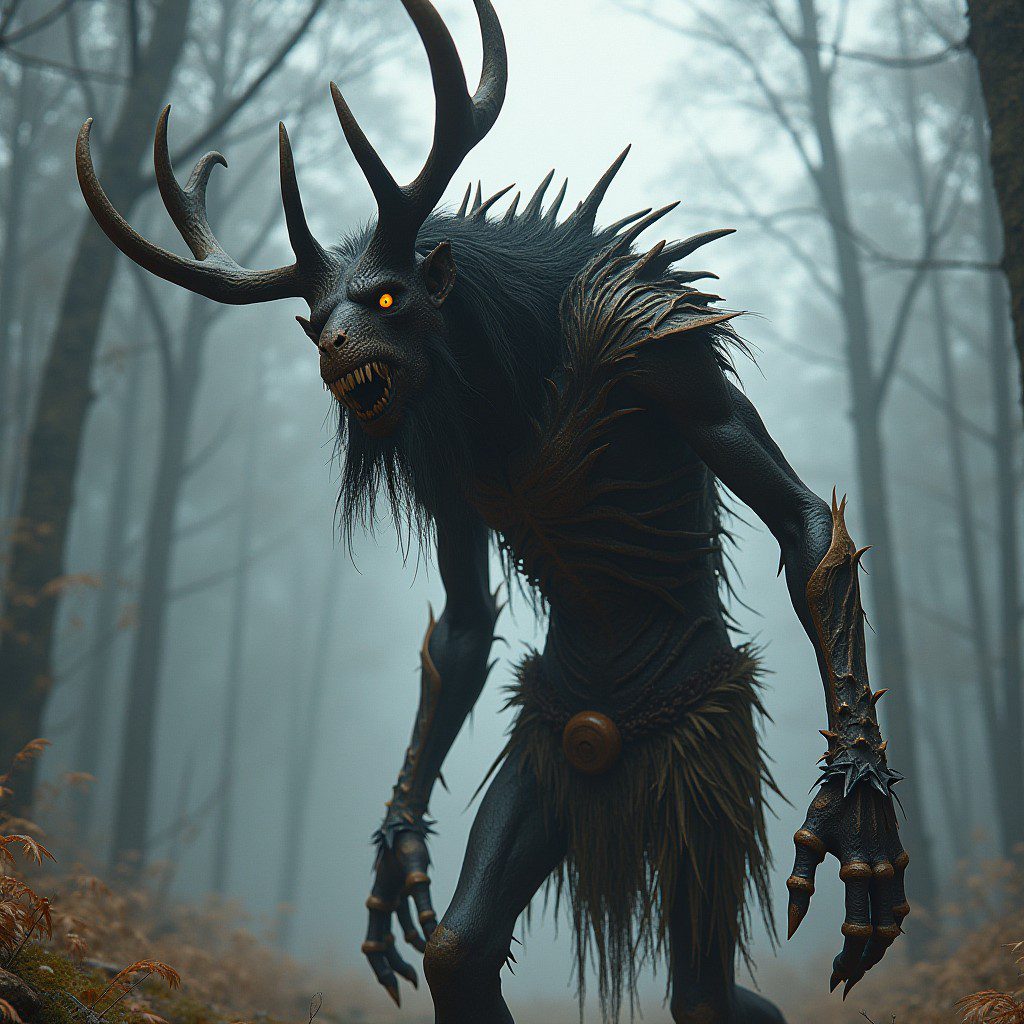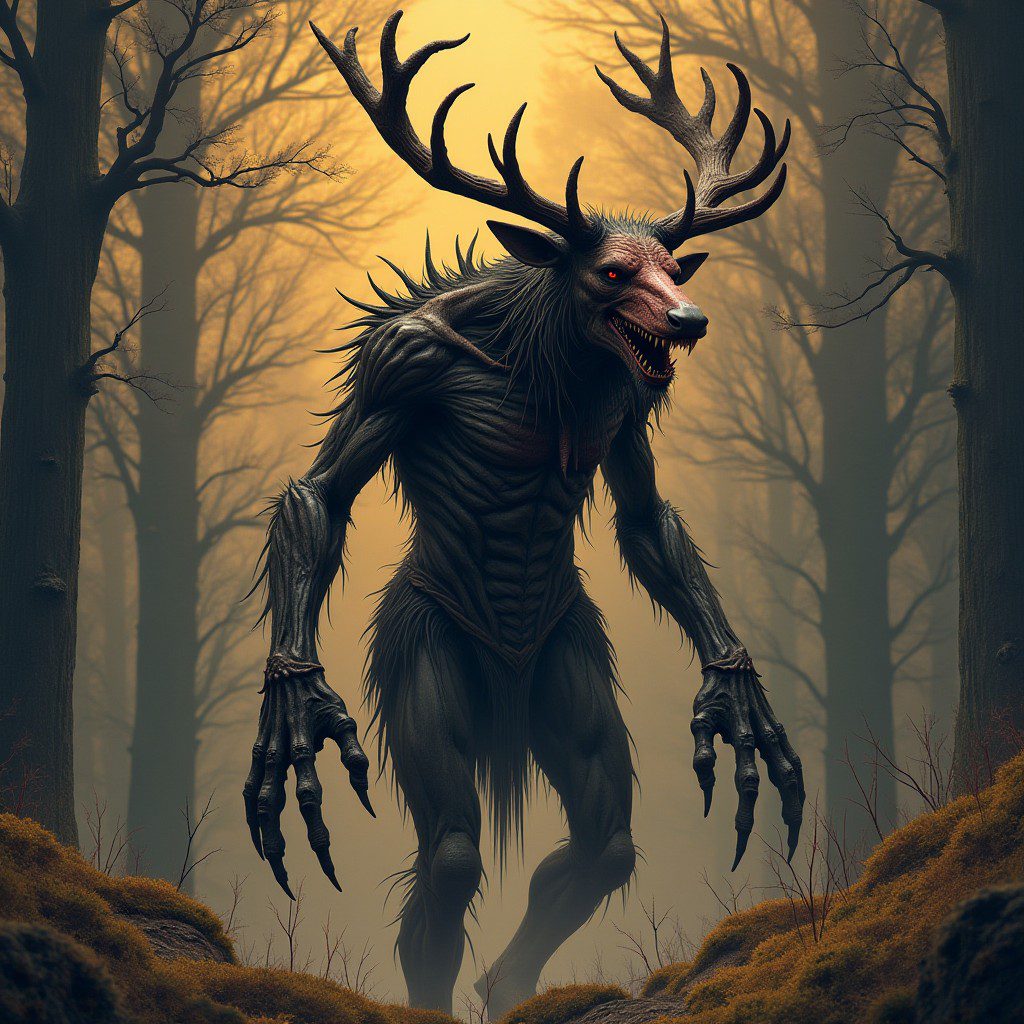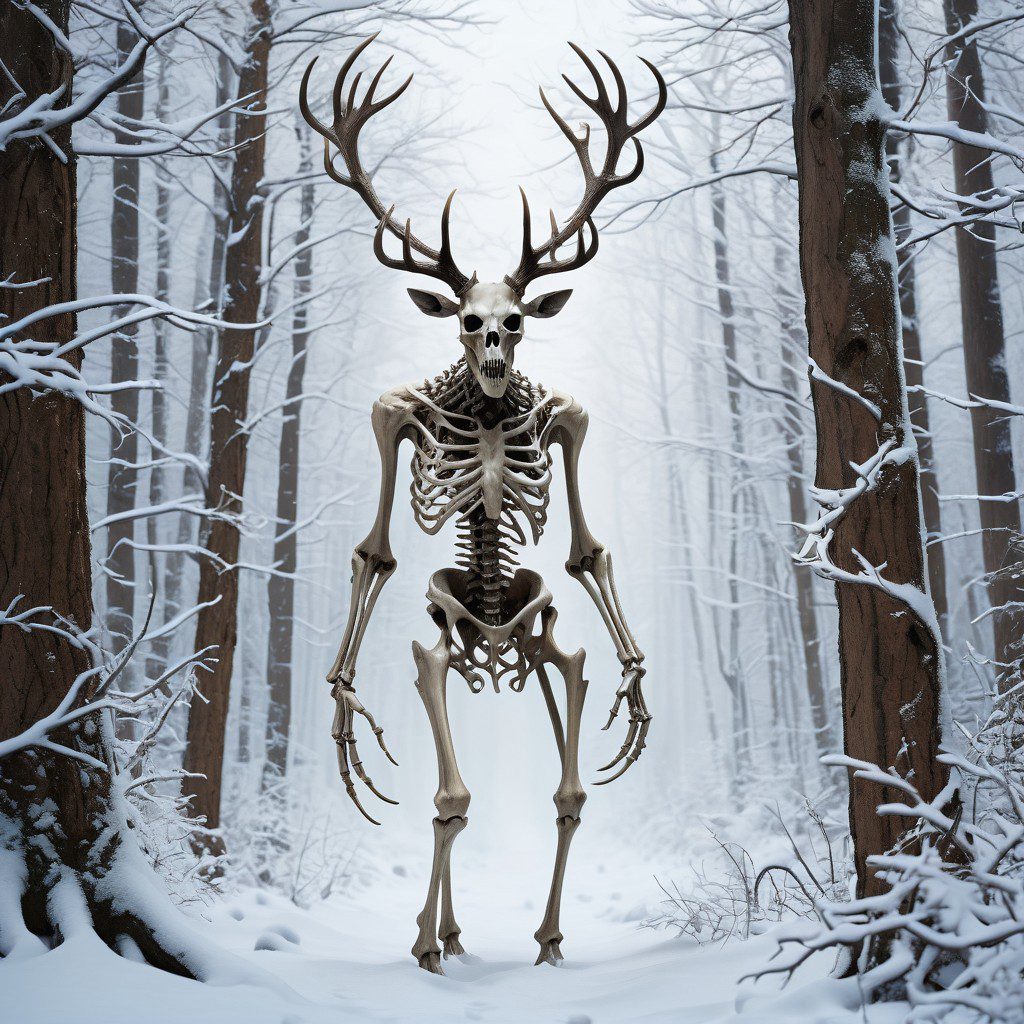Wendigo: The Cannibalistic Spirit of the North

The Wendigo is a malevolent spirit or creature from the folklore of Indigenous peoples of North America, particularly the Algonquin-speaking tribes, including the Cree, Ojibwe, and Innu. The Wendigo is associated with greed, hunger, and cannibalism, often representing the dangers of insatiable desire and the consequences of violating natural and spiritual taboos. In legend, the Wendigo is said to possess individuals, transforming them into monstrous beings with an insatiable hunger for human flesh.
Over time, the Wendigo has become a prominent figure in horror literature and modern media, where it is often portrayed as a terrifying monster lurking in the cold wilderness, preying on the weak and desperate. The Wendigo’s myth highlights the moral consequences of greed and the perils of survival in harsh environments, making it a compelling and enduring symbol in both traditional and modern storytelling.
Origins and Mythological Background
The Wendigo has its roots in the folklore of the Algonquin-speaking peoples of the northern regions of North America, where it is often depicted as a monstrous spirit associated with winter, starvation, and cannibalism. The legend likely arose as a cautionary tale about the dangers of greed and the harsh realities of survival in the frozen wilderness.
Algonquin Mythology
In Algonquin traditions, the Wendigo is a spirit of the cold and the wilderness, associated with starvation and the darkest depths of winter. It is said that the Wendigo can possess humans who engage in cannibalism, particularly those who resort to it out of desperation during times of famine. Once possessed, the individual becomes a Wendigo, a ravenous and twisted creature driven to consume human flesh.
The Wendigo is also portrayed as an embodiment of insatiable greed—a being whose hunger for flesh can never be satisfied, no matter how much it consumes. In this sense, the Wendigo represents the destructive power of unchecked desire and the consequences of breaking social and spiritual taboos. In many versions of the myth, the Wendigo grows in size the more it eats, yet it remains eternally starved, never finding true satisfaction.
The physical appearance of the Wendigo varies across different tribes and stories. Some describe it as a gaunt, skeletal figure with glowing eyes, sharp teeth, and claws. Others depict it as a giant humanoid creature with an emaciated body and the head of a deer or elk, often with antlers. This monstrous form emphasizes the unnatural and horrific nature of the Wendigo, a being that is both human and beast, yet belongs to neither.
The Wendigo’s Transformation and Possession


One of the key elements of Wendigo mythology is the concept of transformation or possession. According to legend, a human can become a Wendigo in several ways:
- Cannibalism: The most common trigger for becoming a Wendigo is cannibalism. In times of extreme starvation, those who resort to eating human flesh are believed to become possessed by the Wendigo spirit, transforming into the creature themselves. This transformation marks the loss of their humanity as they are consumed by insatiable hunger for more flesh.
- Spiritual Possession: In some stories, the Wendigo is a malevolent spirit that can possess individuals, driving them to madness and cannibalism. The possessed individual becomes increasingly isolated and ravenous, eventually turning into a Wendigo. The transformation can be seen as both physical and psychological, as the person loses control over their body and mind.
- Curse: In certain versions of the myth, the Wendigo can be the result of a curse. Those who engage in particularly greedy or selfish behavior may be cursed to become a Wendigo as punishment for their actions. This version of the tale emphasizes the moral lesson behind the Wendigo myth: unchecked greed and selfishness can lead to one’s downfall.
Physical Description of the Wendigo
The appearance of the Wendigo varies slightly between different Indigenous cultures, but some features remain consistent. The Wendigo is typically depicted as:
- Tall and Emaciated: The Wendigo is often described as a towering figure, sometimes over 15 feet tall, with a skeletal, emaciated body. Its skin is tight against its bones, and it appears starved, despite its incredible height and size. This exaggerated thinness symbolizes its endless hunger and inability to feel satiated.
- Deer or Elk Features: In some descriptions, the Wendigo is portrayed with the head of a deer or elk, complete with antlers. This gives the creature a more animalistic, supernatural appearance, blending human and beastly traits.
- Rotting or Decayed Flesh: The Wendigo is frequently depicted as having decayed or frostbitten skin, with a stench of death surrounding it. This imagery reflects the creature’s association with death and the cold, desolate wilderness where it preys on the living.
- Sharp Claws and Teeth: As a predator, the Wendigo is often described with long, sharp claws and jagged teeth, making it a deadly hunter. These features emphasize its violent nature and its role as a cannibalistic monster.
Wendigo in Modern Horror and Media
The Wendigo’s horrifying nature has made it a popular figure in horror literature, films, and video games. Over time, the creature has evolved from its mythological roots into a more general symbol of savagery, isolation, and madness.
1. Literature
- Algernon Blackwood: One of the most famous depictions of the Wendigo in literature comes from Algernon Blackwood’s short story The Wendigo (1910). In this tale, the Wendigo is portrayed as a terrifying supernatural force that preys on those who venture too far into the wilderness. Blackwood’s story captures the eerie, isolating atmosphere of the wilderness and the fear of being hunted by an unseen, malevolent force.
- Stephen King: The Wendigo also makes an appearance in Stephen King’s novel Pet Sematary, where it is described as an evil spirit connected to an ancient burial ground. In King’s story, the Wendigo is not a physical creature but an unseen malevolent presence that influences the dead, leading to terrifying consequences.
2. Film and Television
- Hannibal: In the TV series Hannibal, the Wendigo appears as a symbolic figure representing the character Hannibal Lecter’s predatory nature and insatiable hunger. The show’s version of the Wendigo is more metaphorical, representing Hannibal’s monstrous side rather than a literal cannibalistic creature.
- Antlers: The 2021 film Antlers, directed by Scott Cooper, features the Wendigo as the central antagonist. The film explores the creature’s mythological origins while placing the story in a modern setting. The Wendigo in Antlers is depicted as a terrifying, emaciated being with antlers, following traditional depictions of the creature while emphasizing its connection to human greed and primal instincts.
3. Video Games
- Until Dawn: In the horror video game Until Dawn, the Wendigo serves as one of the primary antagonists. In this version, the Wendigo is the result of people consuming human flesh in the remote wilderness, which transforms them into horrific, emaciated creatures. The game draws heavily from the original Wendigo myth, particularly its themes of cannibalism and isolation.
- Fallout 76: The Wendigo also appears as a monster in Fallout 76, a post-apocalyptic video game. In this depiction, the Wendigo is a mutated creature that hunts the player in dark, desolate areas, further emphasizing its connection to wilderness and fear.
The Symbolism of the Wendigo
The Wendigo serves as a powerful symbol in both its traditional mythological context and in modern horror. It represents the dangers of isolation, unchecked greed, and the violation of social and natural laws. Its association with cannibalism and insatiable hunger reflects the fear of losing one’s humanity when faced with desperation and survival.
1. Greed and Insatiability
In its role as a symbol of greed, the Wendigo warns of the dangers of excessive desire and consumption. The Wendigo’s hunger can never be sated, no matter how much it consumes, making it a cautionary figure about the perils of overindulgence, whether in material wealth or other forms of selfishness.
2. Survival and Cannibalism
The Wendigo is often associated with survival in harsh environments, particularly during the long, cold winters of the northern regions. The myth likely arose as a way to discourage acts of cannibalism during times of famine, reminding people that turning to such acts would lead to spiritual and moral degradation.
3. The Loss of Humanity
The Wendigo represents the loss of humanity that occurs when one gives in to base instincts, such as hunger and greed. Once a person becomes a Wendigo, they lose their identity and are consumed by an all-encompassing need to eat human flesh. This transformation serves as a metaphor for the dehumanizing effects of extreme desperation.
Strengths and Weaknesses of the Wendigo
Strengths:
- Immense Strength and Speed: The Wendigo is often described as being incredibly strong and fast, able to overpower and outrun its prey in the wilderness.
- Heightened Senses: As a hunter, the Wendigo is said to have heightened senses, particularly smell, which allows it to track prey over long distances.
- Insatiable Hunger: The Wendigo’s endless hunger drives it to relentlessly pursue its victims, making it a terrifying and relentless predator.
Weaknesses:
- Fire: In many versions of the myth, fire is one of the few things capable of harming or killing the Wendigo. Fire represents purity and cleansing, making it a fitting weapon against such a malevolent spirit.
- Weakness to Silver or Spiritual Methods: In some modern interpretations, the Wendigo is vulnerable to silver weapons or can be banished through spiritual rituals, similar to how vampires are harmed by silver or holy symbols.
- Isolation: Despite its strength, the Wendigo is often portrayed as a solitary creature. Its isolation, both physically and spiritually, makes it disconnected from the world, unable to engage with it in any way other than through violence and hunger.
The Legacy of the Wendigo
The Wendigo remains one of the most enduring figures in horror and folklore, representing the primal fears of hunger, isolation, and the loss of humanity. Whether as a literal monster in the wilderness or a symbolic figure in stories about greed and cannibalism, the Wendigo’s haunting presence continues to captivate audiences in literature, films, and video games.
Its complex nature—part human, part beast—ensures that the Wendigo will remain a powerful symbol of the dangers lurking in the darkest corners of both the natural world and the human psyche.
